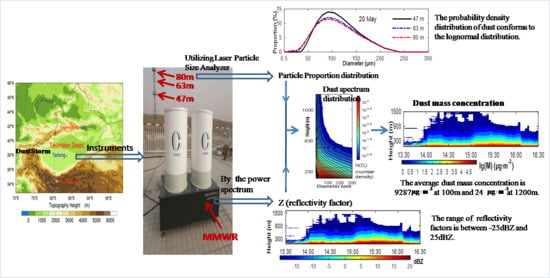Quantitative Detection of Dust Storms with the Millimeter Wave Radar in the Taklimakan Desert
Abstract
1. Introduction
2. Instrumentation and Data
2.1. Site and Instruments
2.2. Description of Dust Storm Processes
3. Method for the Retrieval of Dust Spectrum Distribution
3.1. The Calculation of the Reflectivity Factor
3.2. The Probability Density Distribution of Dust Particles
3.3. The Calculation of theDust Spectrum Distribution
4. The Analysis of the Results
4.1. The Weather Overview
4.2. The Ground Wind Speed
4.3. Reflectivity Factor
4.4. The Dust Spectrum Distributions
4.5. Dust Mass Concentration
4.6. Data Comparison
4.7. Z–MRelationship
5. Discussions
6. Conclusions
Author Contributions
Funding
Acknowledgments
Conflicts of Interest
References
- Lau, K.M.; Kim, K.M. Asian summer monsoon anomalies induced by aerosol direct forcing: The role of the Tibetan Plateau. Clim. Dyn. 2006, 26, 855–864. [Google Scholar] [CrossRef]
- Wang, M.; Wei, W.; Ruan, Z.; He, Q.; Ge, R. Application of wind-profiling radar data to the analysis of dust weather in the Taklimakan Desert. Environ. Monit. Assess. 2013, 185, 4819–4834. [Google Scholar] [CrossRef] [PubMed]
- Baddock, M.C.; Strong, C.L.; Murray, P.S.; McTainsh, G.H. Aeolian dust as a transport hazard. Atmos. Environ. 2013, 71, 7–14. [Google Scholar] [CrossRef]
- Sprigg, W.A.; Nickovic, S.; Galgiani, J.N.; Pejanovic, G.; Petkovic, S.; Vujadinovic, M.; Vukovic, A.; Dacic, M.; DiBiase, S.; Prasad, A.; et al. Regional dust storm modeling for health services: The case of valley fever. Aeolian Res. 2014, 14, 53–73. [Google Scholar] [CrossRef]
- Yan, Y.; Sun, Y.Z.; Ma, L.; Long, X. A multidisciplinary approach to trace Asian dust storms from source to sink. Atmos. Environ. 2015, 105, 43–52. [Google Scholar] [CrossRef]
- Ramanathan, V.; Crutzen, P.J.; Kiehl, J.T.; Rosenfeld, D. Aerosols, climate, and the hydrological cycle. Science 2001, 294, 2119–2124. [Google Scholar] [CrossRef] [PubMed]
- Uno, I.; Eguchi, K.; Yumimoto, K.; Takemura, T.; Shimizu, A.; Uematsu, M.; Liu, Z.; Wang, Z.; Hara, Y.; Sugimoto, N. Asian dust transported one full circuit around the globe. Nat. Geosci. 2009, 2, 557–560. [Google Scholar] [CrossRef]
- Mallet, M.; Tulet, P.; Serca, D.; Solmon, F.; Dubovik, O.; Pelon, J.; Pont, V.; Thouron, O. Impact of dust aerosols on the radiative budget, surface heat fluxes, heating rate profiles and convective activity over West Africa during March 2006. Atmos. Chem. Phys. 2009, 9, 7143–7160. [Google Scholar] [CrossRef]
- Prospero, J.M.; Lamb, P.J. African droughts and dust transport to the Caribbean: Climate change implications. Science 2003, 302, 1024–1027. [Google Scholar] [CrossRef]
- Kaufman, Y.J.; Koren, I.; Remer, L.A.; Tanre, D.; Ginoux, P.; Fan, S. Dust transport and deposition observed from the Terra-Moderate resolution Imaging Spectroradiometer (MODIS) spacecraft over the Atlantic Ocean. J. Geophs. Res. 2005, 110, D10S12. [Google Scholar] [CrossRef]
- Reid, J.S.; Koppmann, R.; Eck, T.K.; Eleuterio, D.P. A review of biomass burning emissions part II: Intensive physical properties of biomass burning particles. Atmos. Chem. Phys. 2005, 5, 799–825. [Google Scholar] [CrossRef]
- Ganor, E.; Stupp, A.; Alpert, P. A method to determine the effect of mineral dust aerosols on air quality. Atmos. Environ. 2009, 43, 5463–5468. [Google Scholar] [CrossRef]
- Mamouri, R.E.; Ansmann, A. Fine and coarse dust separation with polarization lidar. Atmos. Meas. Tech. Discuss. 2014, 7, 5173–5221. [Google Scholar] [CrossRef]
- Mamouri, R.E.; Ansmann, A.; Nisantzi, A.; Solomos, S.; Kallos, G.G.; Hadjimitsis, D. Extreme dust storm over the eastern Mediterranean in September 2015: Satellite, lidar, and surface observations in the Cyprus region. Atmos. Chem. Phys. 2016, 16, 13711–13724. [Google Scholar] [CrossRef]
- Lei, H.; Wang, J.X.L. Observed characteristics of dust storm events over the western United States using meteorological, satellite, and quality measurements. Atmos. Chem. Phys. 2014, 14, 7847–7857. [Google Scholar] [CrossRef]
- Kai, K.; Nagata, Y.; Tsunematsu, N.; Matsumura, T.; Kim, H.S.; Matsumoto, T.; Hu, S.; Zhou, H.; Abo, M.; Nagai, T. The structure of the dust layer over the Taklimakan Desert during the dust storm in April 2002 as observed using a depolarization lidar. J. Meteorol. Soc. Jpn. 2008, 86, 1–16. [Google Scholar] [CrossRef][Green Version]
- Naeger, A.R.; Christopher, S.A.; Johnson, B.T. Multiplatform analysis of the radiative effects and heating rates for an intense dust storm on 21 June 2007. J. Geophys. Res. Atmos. 2013, 118, 9316–9329. [Google Scholar] [CrossRef]
- Scheuvens, D.; Schuetz, L.; Kandler, K.; Ebert, M.; Weinbruch, S. Bulk composition of northern African dust and its source sediments—A compilation. Earth Sci. Rev. 2013, 116, 170–194. [Google Scholar] [CrossRef]
- Mallet, M.; Dulac, F.; Formenti, P.; Nabat, P.; Sciare, J.; Roberts, G.; Pelon, J.; Ancellet, G.; Tanré, D.; Parol, F.; et al. Overview of chemistry-aerosol Mediterranean experiment/aerosol direct radiative forcing on the Mediterranean climate (ChArMEx/ADRIMED) summer 2013 campaign. Atmos. Chem. Phys. 2016, 16, 455–504. [Google Scholar] [CrossRef]
- Wang, M.Z.; Ming, H.; Huo, W.; Xu, H.X.; Li, J.G.; Li, X.C. Detecting sand-dust storms using a wind-profiling radar. J. Arid Land 2017, 9, 753–762. [Google Scholar] [CrossRef]
- Takano, T.; Yamaguchi, J.; Abe, H.; Futaba, K.I.; Yokote, S.I.; Kawamura, Y.; Takamura, T.; Kumagai, H.; Ohno, Y.; Nakanishi, Y.; et al. Development and performance of Millimeter-Wave cloud profiling radar at 95 GHZ: Sensitivity and spatial resolution. IEEJ Trans. Fundam. Mater. 2010, 93, 42–49. [Google Scholar] [CrossRef]
- Wang, Y.; Wang, C.H.; Shi, C.Z.; Xiao, B.H. Integration of cloud top heights retrieved from FY-2 meteorological satellite radiosonde, and ground-based millimeter wavelength cloud radar observations. Atmos. Res. 2018, 214, 284–295. [Google Scholar] [CrossRef]
- Wang, Z.; Wang, Z.H.; Cao, X.Z.; Tao, F. Comparison of cloud top heights derived from FY-2 meteorological satellites with heights derived from ground-based millimeter wavelength cloud radar. Atmos. Res. 2017, 199, 113–127. [Google Scholar] [CrossRef]
- Bryan, S.; Clarke, A.; Vanderkluysen, L.; Groppi, C.; Paine, S. Measuring water vapor and Ash in Volcanic Eruptions with a millimeter-wave radar/imager. IEEE Trans. Geosci. Remote Sens. 2017, 55, 3177–3184. [Google Scholar] [CrossRef]
- Zhao, C.; Liu, L.; Wang, Q.; Qiu, Y.; Wang, Y.; Wu, X. MMCR-based characteristic properties of non-precipitation cloud liquid droplets at Naqu site over Tibetan Plateau in July 2014. Atmos. Res. 2017, 190, 68–76. [Google Scholar] [CrossRef]
- Ayhan, S.; Pauli, M.; Scherr, S.; Göttel, B.; Bhutani, A.; Thomas, S.; Jaeschke, T.; Panel, J.M.; Vivier, F.; Eymard, L.; et al. Millimeter-wave radar sensor for snow height measurements. IEEE Trans. Geosci. Remote Sens. 2017, 55, 854–861. [Google Scholar] [CrossRef]
- Chen, H.Y.; Ku, C.C. Calculation of wave attenuation in sand and dust storms by the FDTD and turning bands methods at 10–100 GHz. IEEE Trans. Antennas Propag. 2012, 60, 2951–2960. [Google Scholar] [CrossRef]
- Dong, Q.F.; Li, Y.L.; Xu, J.D.; Zhang, H.; Wang, M.J. Effect of sand and dust storms on microwave propagation. IEEE Trans. Antennas Propag. 2013, 61, 910–9162. [Google Scholar] [CrossRef]
- Dong, Q.F.; Li, Y.L.; Xu, J.D.; Zhang, H.; Wang, M.J. Backscattering characteristics of millimeter wave radar in sand and dust storms. J. Electromagn. Wave Appl. 2014, 28, 1075–1084. [Google Scholar] [CrossRef]
- Juan, W.; Li, X.; Wang, M.; Sun, W. Theoretical analysis of potential applications of microwave radar for sandstorm detection. Theor. Appl. Climatol. 2019, 137, 1–6. [Google Scholar] [CrossRef]
- Nashashibi, A.Y.; Sarabandi, K.; Al-Zaid, F.A.; Alhumaidi, S. Characterization of radar backscatter response of sand-covered surfaces at Millimeter-Wave frequencies. IEEE Trans. Geosci. Remote Sens. 2012, 50, 2345–2354. [Google Scholar] [CrossRef]
- Yuan, H.; Zhuang, G.; Li, J.; Wang, Z.; Li, J. Mixing of mineral with pollution aerosols in dust season in Beijing: Revealed by source apportionment study. Atmos. Environ. 2008, 42, 2141–2157. [Google Scholar] [CrossRef]
- Choobari, O.A.; Zawar-Reza, P.; Sturman, A. The global distribution of mineral dust and its impacts on the climate system: A review. Atmos. Res. 2014, 138, 152–165. [Google Scholar] [CrossRef]
- Liu, L.X.; Huang, X.; Ding, A.J.; Fu, C.B. Dust- induced radiative feedbacks in north China: A dust storm episode modeling study using WRF-Chem. Atmos. Environ. 2016, 129, 43–54. [Google Scholar] [CrossRef]
- Chen, S.; Huang, J.P.; Zhao, C.; Qian, Y.; Leung, L.R.; Yang, B. Modeling the transport and radiative forcing of Taklimakan dust over the Tibetan plateau: A case study in the summer of 2006. J. Geophys. Res. Atmos. 2013, 118, 797–812. [Google Scholar] [CrossRef]
- Rashki, A.; Arjmand, M.; Kakaoutis, D.G. Assessment of dust activity and dust- plume pathways over Jazmurian Basin, southeast Iran. Aeolian Res. 2017, 24, 145–160. [Google Scholar] [CrossRef]
- Rashki, A.; Kaskaoutis, D.G.; Sepehr, A. Statistical evaluation of the dust events at selected stations in Southwest Asia: From the Caspian Sea to the Arabian Sea. Catena 2018, 165, 590–603. [Google Scholar] [CrossRef]
- Zhang, P.C.; Du, B.Y.; Dai, T.P. Radar Meteorology; China Meteorological Press: Beijing, China, 2000; pp. 77–87. (In Chinese) [Google Scholar]
- Dong, Q.S. Physical characteristics of the sand and dust in different deserts of China. Chin. J. Radio Sci. 1997, 12, 15–25. (In Chinese) [Google Scholar]
- Dong, Z.B.; Man, D.Q.; Luo, W.Y.; Qian, G.Q.; Wang, J.H.; Zhao, M.; Liu, S.Z.; Zhu, G.Q.; Zhu, S.J. Horizontal aeolian sediment flux in the Minqin area, a major source of Chinese dust storms. Geomorphology 2010, 116, 58–66. [Google Scholar] [CrossRef]
- Liu, X.C.; Zhong, Y.T.; He, Q. Ali MMTM, Observation study on mass concentration of dust aerosols in the Taklimakan Desert hinterland. China Environ. Sci. 2011, 31, 1609–1617. (In Chinese) [Google Scholar]
- Huo, W.; He, Q.; Yang, F.; Yang, X.; Yang, Q.; Zhang, F.; Mamtimin, A.; Liu, X.; Wang, M.; Zhao, Y.; et al. Observed particle sizes and fluxes of Aeolian sediment in the near surface layer during sand—Dust storms in the Taklamakan Desert. Theor. Appl. Climatol. 2017, 130, 735–746. [Google Scholar] [CrossRef]
- Niu, S.J.; Sun, Z.B. Aircraft measurements of sand aerosol over Northwest China desert area in late spring. Plateau Meteorol. 2005, 24, 604–610. (In Chinese) [Google Scholar]
- You, L.G.; Ma, P.M.; Chen, J.H.; Li, K. A case study of the aerosol characteristics in the lower troposphere during a dust storm event. J. Appl. Meteorol. Sci. 1991, 2, 13–21. (In Chinese) [Google Scholar]
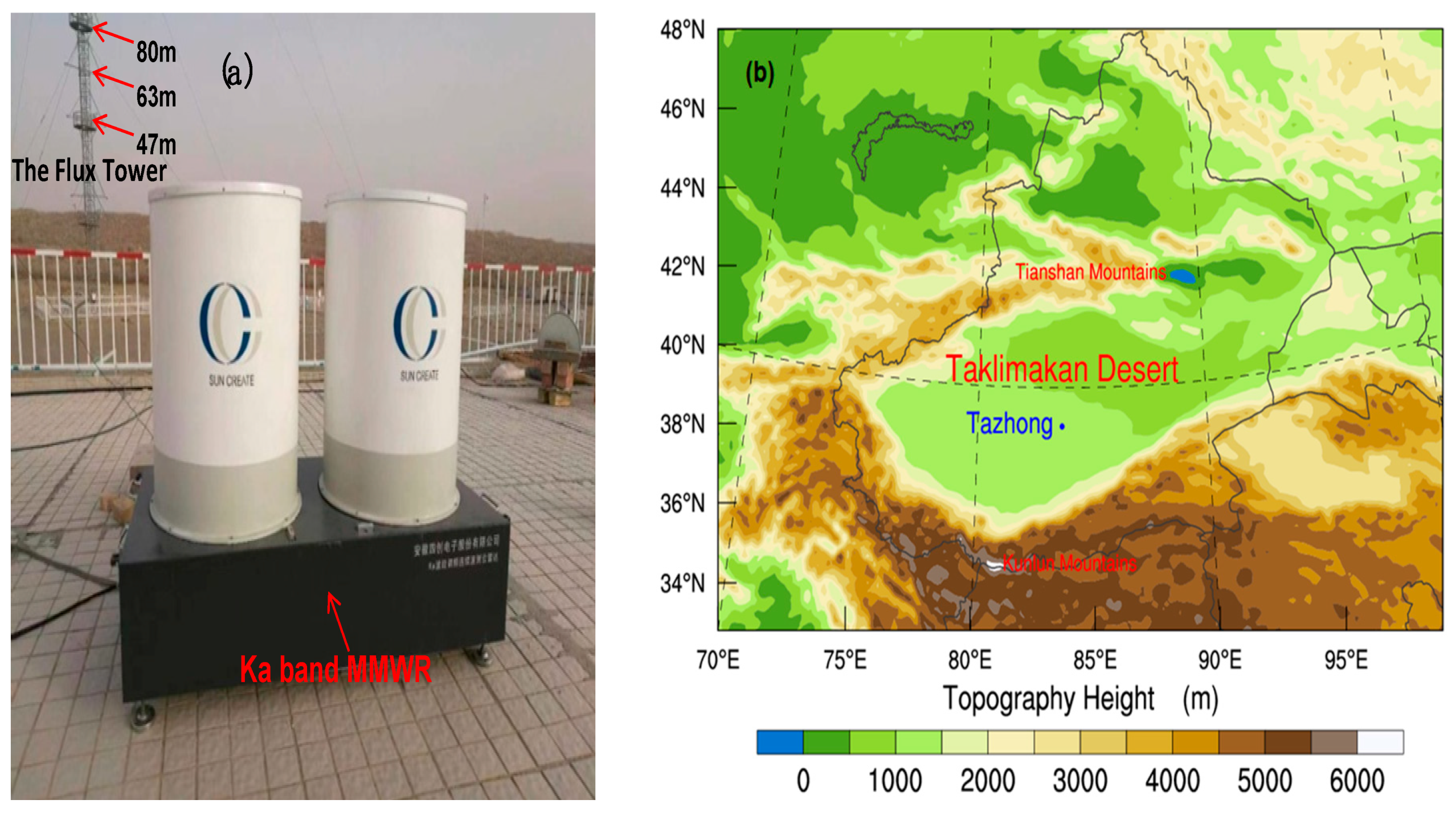

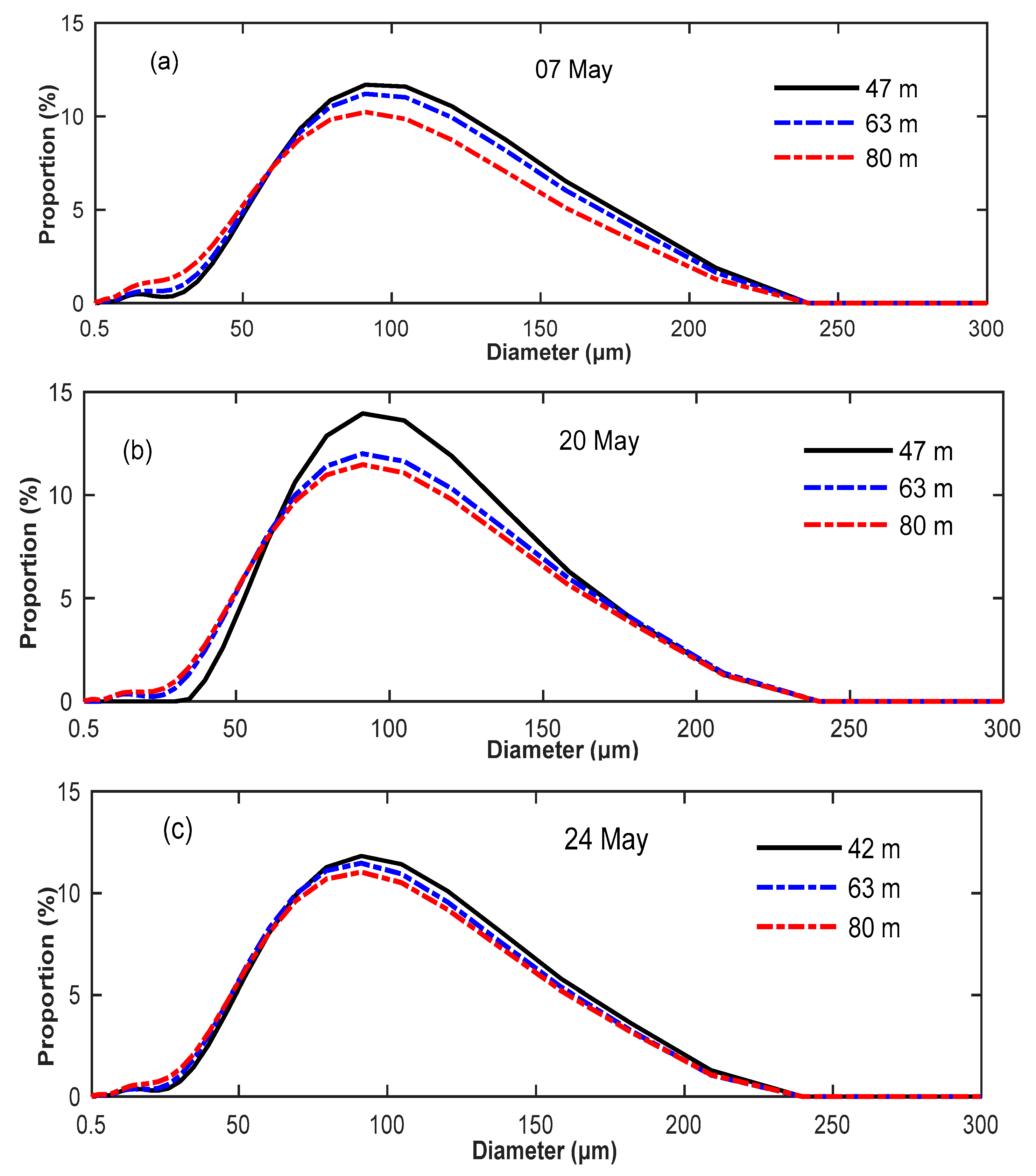
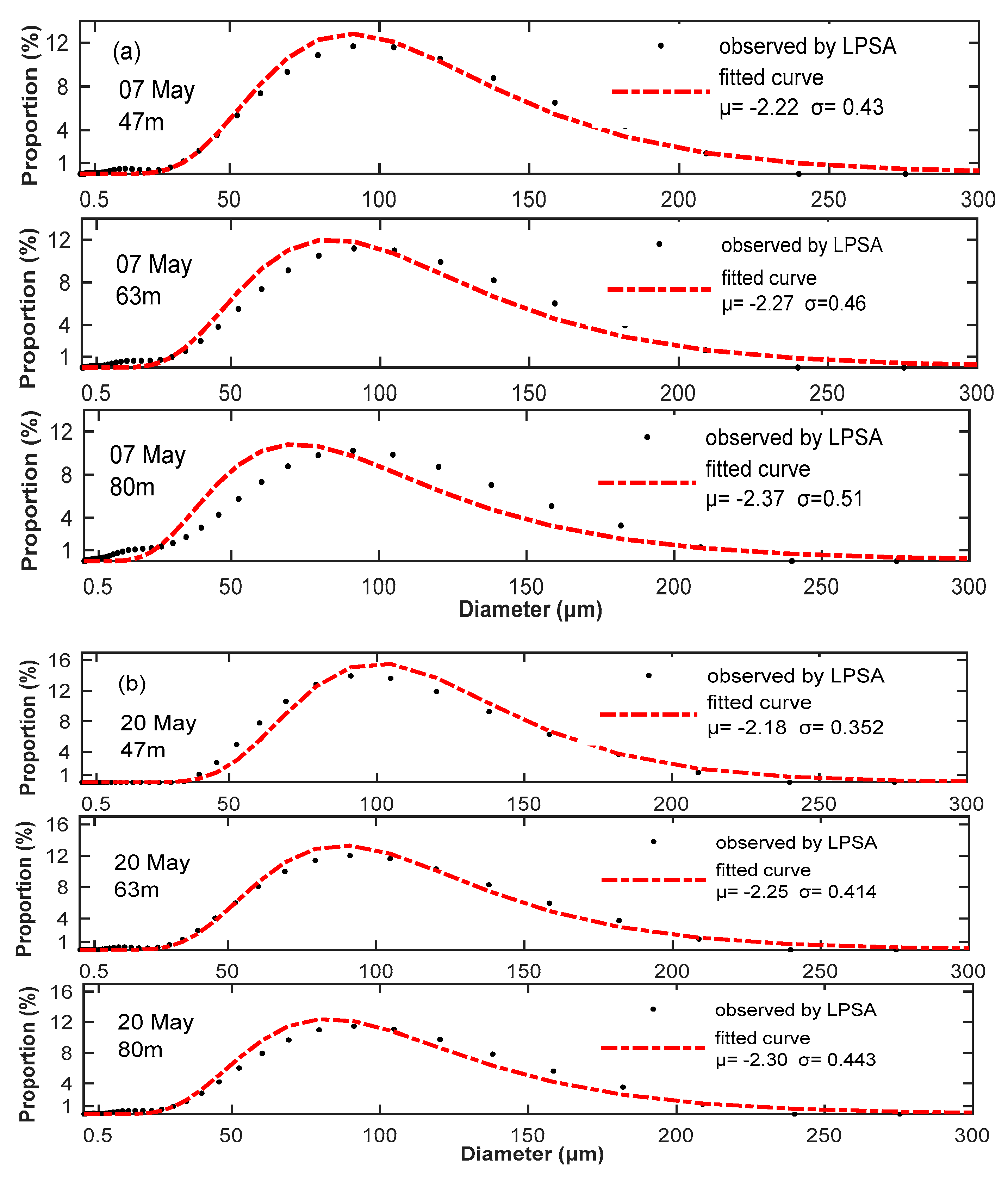


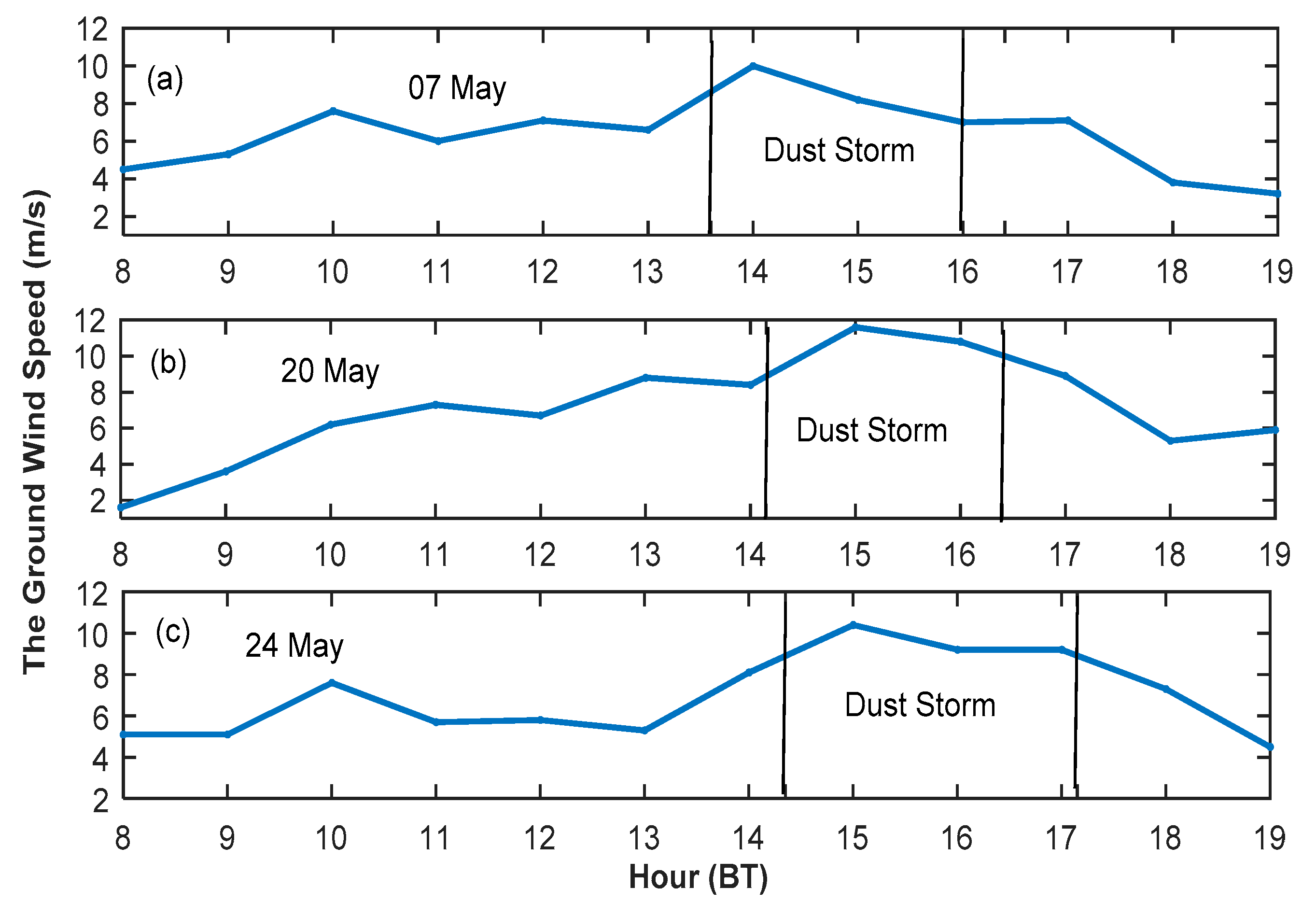
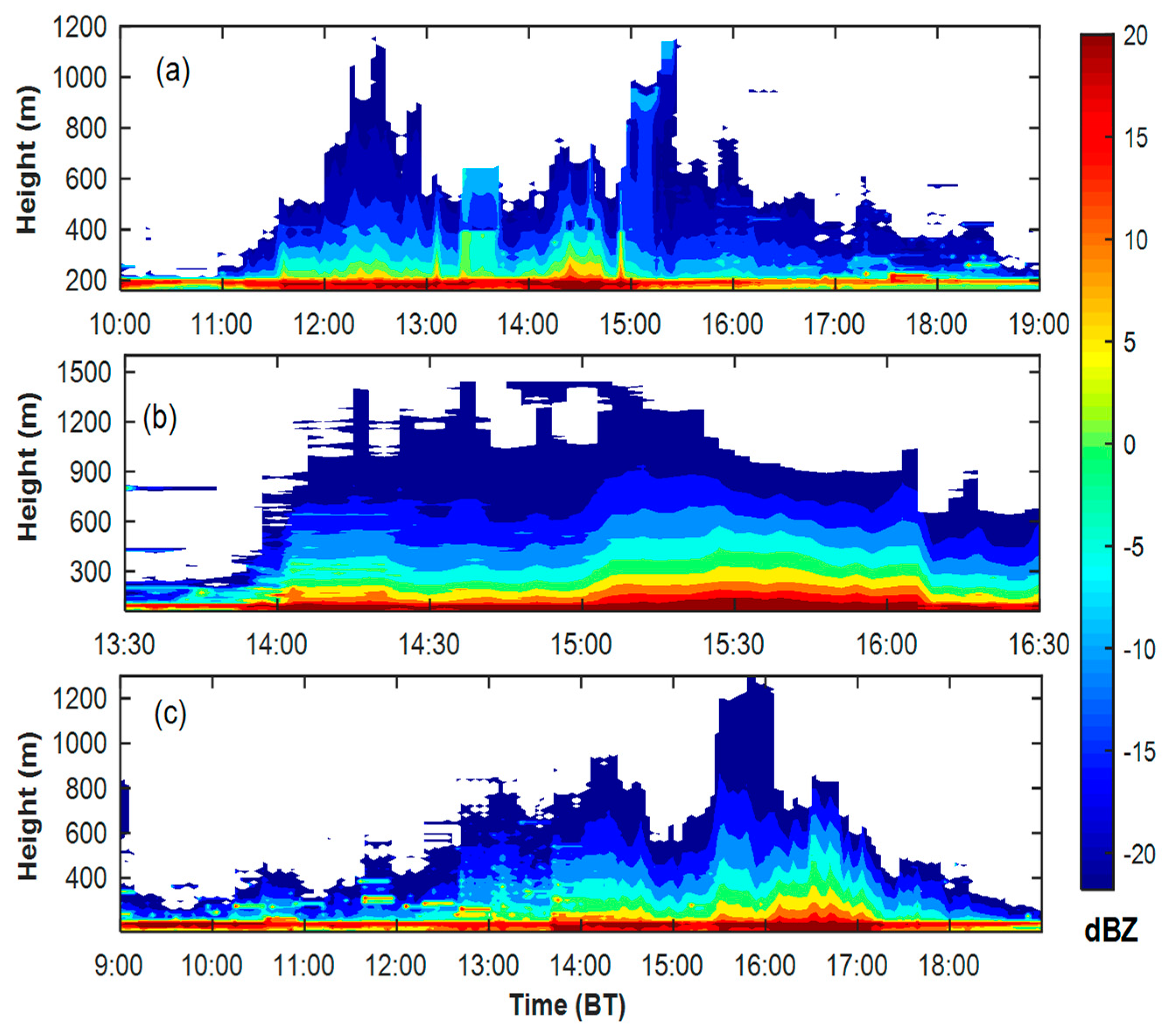
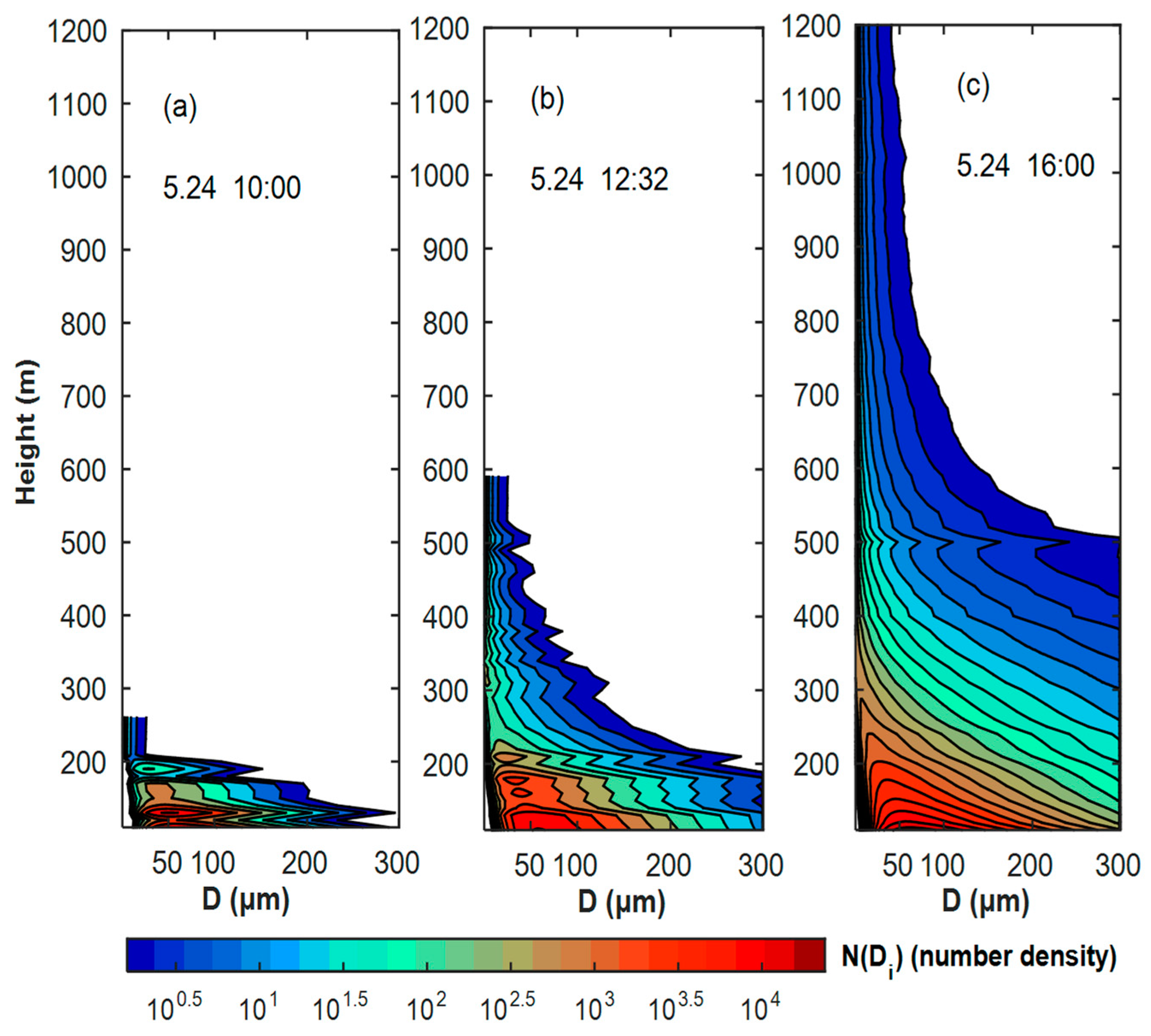
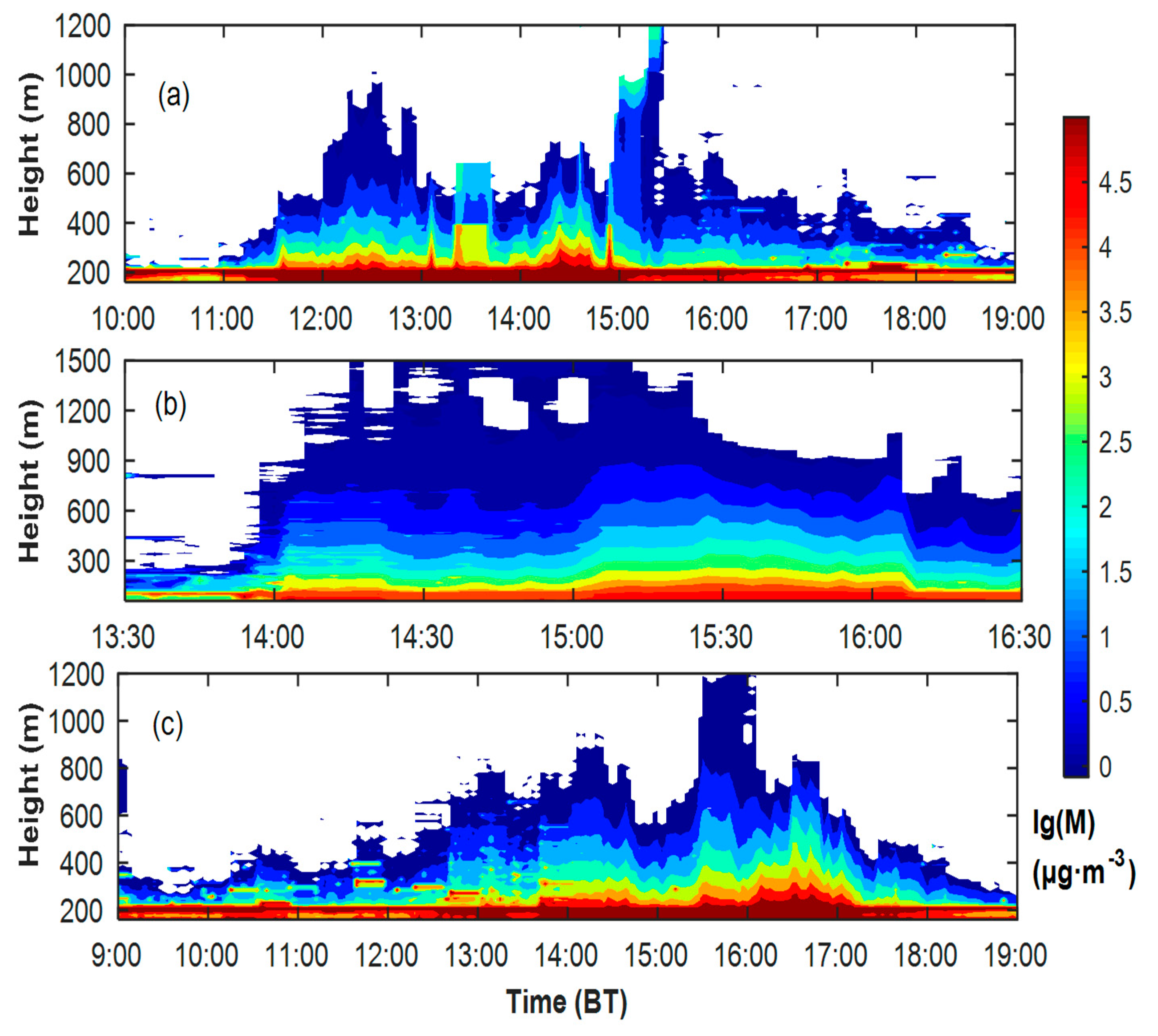

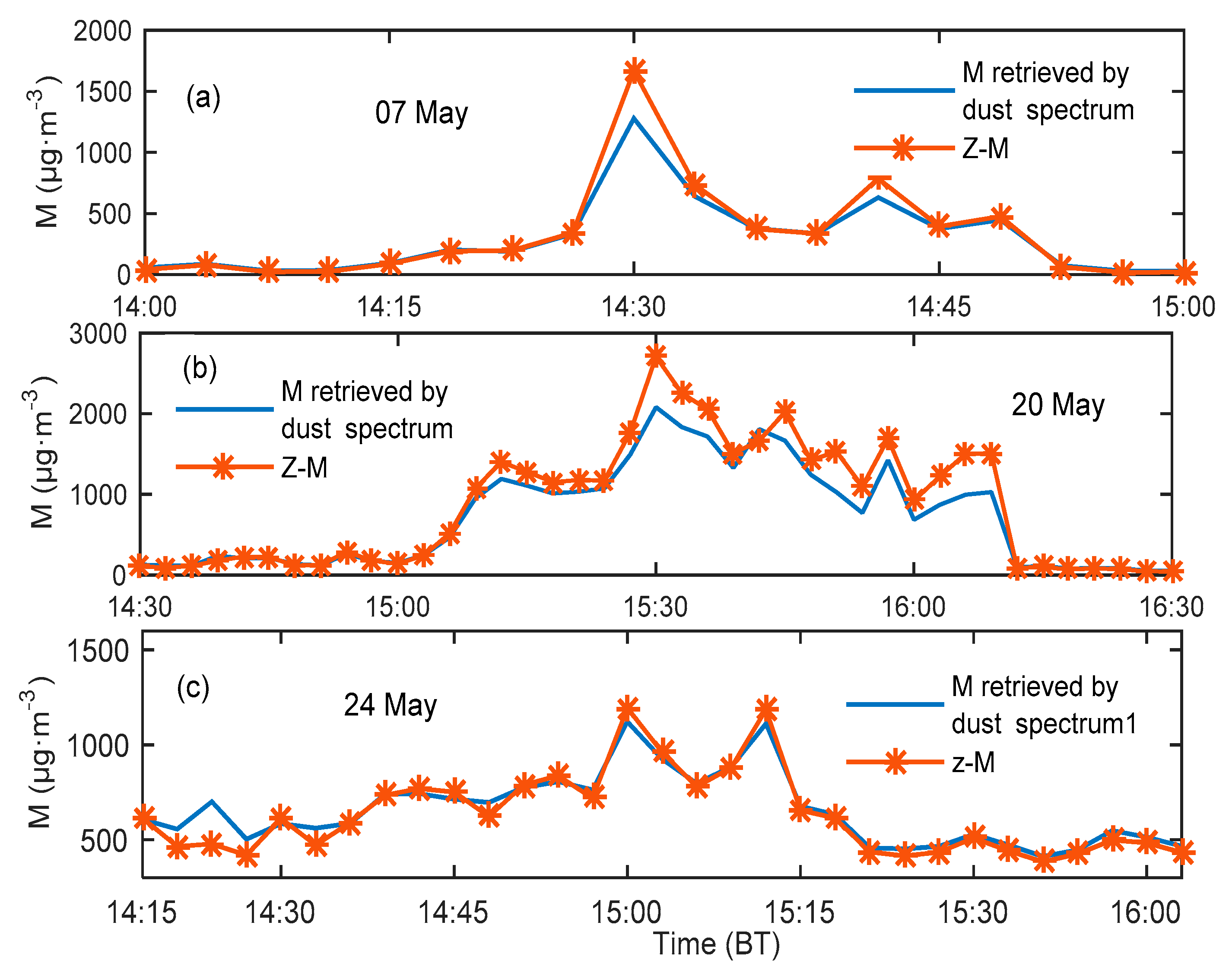
| Parameter Name | Value | Parameter Name | Value |
|---|---|---|---|
| Wavelength | Pulse width | ||
| Range resolution | 10 m | Transmit power | 10 w |
| Center frequency | 35 GHz | FFT points | 256 |
| Horizontal beam width | Feeder loss | 1.2 dB | |
| Vertical beam width | Antenna gain | 40 dB |
| Date | Floating Dust | Blowing Sand | Dust Storm |
|---|---|---|---|
| 7 May | 11:00–11:30; 17:30–19:00 | 11:30–13:35; 16:00–17:30 | 13:35–16:00 |
| 20 May | 13:30–13:40 | 13:40–14:10; 16:08–16:30 | 14:10–16:08 |
| 24 May | 8:50–12:00; 17:20–19:00 | 12:00–14:20; 17:10–17:20 | 14:20–17:10 |
| Height (m) | ||||||||
|---|---|---|---|---|---|---|---|---|
| 7 May | 20 May | 24 May | Average | 7 May | 20 May | 24 May | Average | |
| 47 | −2.22 | −2.18 | −2.27 | −2.22 | 0.43 | 0.352 | 0.426 | 0.403 |
| 63 | −2.27 | −2.25 | −2.31 | −2.28 | 0.46 | 0.414 | 0.440 | 0.438 |
| 80 | −2.37 | −2.30 | −2.34 | −2.34 | 0.51 | 0.443 | 0.462 | 0.472 |
| Height (m) | Range of the Reflectivity Factor (dBZ) | Average Reflectivity Factor (dBZ) | Statistical Cumulative Time (min) |
|---|---|---|---|
| 100 | 12.2~24.7 | 18.3 | 427 |
| 200 | 2.5~17.2 | 10.2 | 413 |
| 500 | −12.6~14.4 | 4.5 | 285 |
| 800 | −18.3~9.5 | −8.7 | 198 |
| 1000 | −22.8~−3.7 | −13.4 | 126 |
| 1200 | −23.7~−7.1 | −14.5 | 86 |
| Height (m) | Range of the Mass Concentration | Average Mass Concentration | Statistical Cumulative Time (min) |
|---|---|---|---|
| 100 | 1220~42,146 | 9287 | 427 |
| 200 | 32~6815 | 515 | 413 |
| 500 | 16~3825 | 70 | 285 |
| 800 | 10~1825 | 36 | 198 |
| 1000 | 8~1280 | 28 | 126 |
| 1200 | 2~820 | 24 | 86 |
© 2019 by the authors. Licensee MDPI, Basel, Switzerland. This article is an open access article distributed under the terms and conditions of the Creative Commons Attribution (CC BY) license (http://creativecommons.org/licenses/by/4.0/).
Share and Cite
Ming, H.; Wei, M.; Wang, M. Quantitative Detection of Dust Storms with the Millimeter Wave Radar in the Taklimakan Desert. Atmosphere 2019, 10, 511. https://doi.org/10.3390/atmos10090511
Ming H, Wei M, Wang M. Quantitative Detection of Dust Storms with the Millimeter Wave Radar in the Taklimakan Desert. Atmosphere. 2019; 10(9):511. https://doi.org/10.3390/atmos10090511
Chicago/Turabian StyleMing, Hu, Ming Wei, and Minzhong Wang. 2019. "Quantitative Detection of Dust Storms with the Millimeter Wave Radar in the Taklimakan Desert" Atmosphere 10, no. 9: 511. https://doi.org/10.3390/atmos10090511
APA StyleMing, H., Wei, M., & Wang, M. (2019). Quantitative Detection of Dust Storms with the Millimeter Wave Radar in the Taklimakan Desert. Atmosphere, 10(9), 511. https://doi.org/10.3390/atmos10090511



